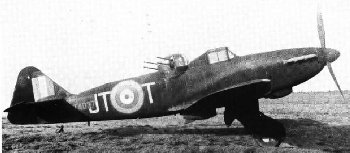

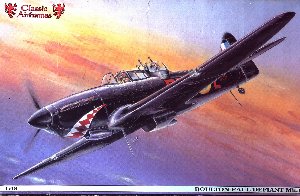
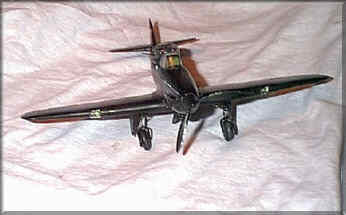




|
|
|
|
|
|
|
|
|
Boulton Paul Defiant |
|
|
|
|
|
7 |
The Defiant was one of the interesting experiments in fighter design known as a "Turret fighter." With all of its armament concentrated in a turret, it was thought an ideal bomber destroyer. It did well, until dedicated fighters attacked - even then, with proper tactics, it could hold its own (especially when mistaken for a Hurricaine, which had a similar profile.). One squadron that did not use them was beaten badly, and led to the type being removed from day fighter duties. It went on to be usedsuccessfully as a night fighter until 1943, with some aircraft having early AI mk. I or II radar sets.
The kit is a limited run injected molded kit. There are some resin bits (the cockpit tub, turret, and machine gun barrels) and vac-form parts (the canopy and turret glass.) The plastic the majority of the parts are moulded in has a somewhat rough finish and (typical of some limited run kits) thick sprue attachment points. This kit will require some cleaning up. What would show as flash on other kits came up as very long "lumps" on my kit that had to be shaved down and sanded off. There are no alignment pins or other aids, so you may want to glue in some plastic strip to help out. A quick test fit shows there's some slight warping in the body halves, but nothing careful gluing can't fix. Decals are provided for two machines, one in Battle of Britain-era day fighter camoflage, and one in an all-black, sharkmouthed nightfighter.
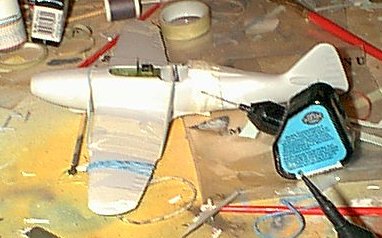 As stated earlier, this model has a good bit of warp in the fuselage halves. Running under hot water, and flattening them on the counter, didn't do much good (though it did help a little.) To deal with this, I checked the fit of the resin cockpit (which fit well,) put in blanking plates of sheet plastic behind the exhausts, and glued the fuselage together, starting at the back. I used liquid cement, "tacking" down every inch and a half or so with cyanoacrylate. Even with this, there was a gap at the rear turret fairing and the point the fuselage meets the aft of the wing, but they weren't major. The only problem was that the front fuselage halves were misaligned slightly (maybe 1/16 of an inch.) The panel lines came together, however, so I fixed this with a shim of plastic card, cut and sanded to shape.
As stated earlier, this model has a good bit of warp in the fuselage halves. Running under hot water, and flattening them on the counter, didn't do much good (though it did help a little.) To deal with this, I checked the fit of the resin cockpit (which fit well,) put in blanking plates of sheet plastic behind the exhausts, and glued the fuselage together, starting at the back. I used liquid cement, "tacking" down every inch and a half or so with cyanoacrylate. Even with this, there was a gap at the rear turret fairing and the point the fuselage meets the aft of the wing, but they weren't major. The only problem was that the front fuselage halves were misaligned slightly (maybe 1/16 of an inch.) The panel lines came together, however, so I fixed this with a shim of plastic card, cut and sanded to shape.
While working on this, I put the cockpit together. The photoetch seat - which I normally don't like - went together very easily. The entire front office almost fell together, with good fit. An overall Interior Green, with some slight chipping (not much, as it's not very visible through the canopy) was done. The instrument panel (photoetch, with film) was added, and looks quite nice - pity nobody'll ever be able to see it! Photoetch seat harnesses are included, as well, though they seem a bit long for the back harnesses.
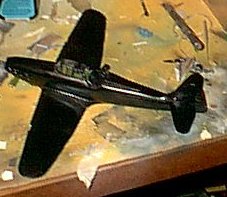 The next thing I worked on was the wing. I added the landing gear bay - they provide just a large "box," though the walkaround I found aftereward shows what appears to be enclosed wells. If only I'd seen this earlier... The upper wings were added, and set aside to dry. Some putty was needed to fill in gaps in the front edge, usually caused from trimming the thick sprue gates.
The next thing I worked on was the wing. I added the landing gear bay - they provide just a large "box," though the walkaround I found aftereward shows what appears to be enclosed wells. If only I'd seen this earlier... The upper wings were added, and set aside to dry. Some putty was needed to fill in gaps in the front edge, usually caused from trimming the thick sprue gates.
The completed cockpit fit in easily to the joined fuselage. Some of the thickest "flash" or overruns had to be sanded down to a reasonably level state, then putty was used to even everything out and fill in the gaps. The wing was then joined - the fuselage had to be "squeezed" somewhat to fit in, but the join itself was reasonably good. Some sanding and putty was needed at the wing roots - and more on the underside, where the wing and fuselage met. This was probably the worst spot on the kit, with a good sized step and gap where everything else was tight. This was set aside to dry, and when dry, sanded smooth.
I still hadn't built the turret assembly yet... a quick test fit of the two halves shows it will drop in easily. I decided to wait so as not to have to paint around the guns. I did, however, seperate and paint the vac-form canopies (Spares are provided... this is a good thing. Suprisingly, I didn't need them.) In fact, after fitting the front canopy and the tailplanes, I started painting the aircraft semi-matte black (this is PollyScale's Aircraft Interior Black.) I decided (for some reason) to handbrush these instead of use the airbrush... let me say, they hand brush beautifully. Not a brushmark in sight! I let the top half dry, and planned my attack on the rest of the kit.
I drilled out the locating holes for the landing gear legs next, This area was also black, as were the landing gear legs. I trimmed the flash from the legs, added the photoetch oleos (and what looks like a tire scraper) and connected them... nice fit. The retraction gear (photoetch and brass tube) will go on once those have set a bit. While waiting for that, I built the ventral radiator (plastic and photoetch,) painted the undersurface where it was to go black, and glued it on. It matched up very nicely.
Suprisingly... this has only taken two days so far! When did I get this far on the kit... Putting my concerns aside, I bent toward assembling the little bits - tires for the landing gear (two parts, and the center needs to be drilled - putty and sanding will be needed here,) and the propeller and spinner... uh oh.
The rear disk of the spinner is molded with the hub... and not well. In addition, the blades are molded into the hub - or should be! Only one blade remained. A second was found floating in the box. The third... I went through my spares box, and found a propeller that could be modified to resemble the other two. A quick strip of old paint, and sanding to shape... whala... a full hub. I added the spinner, puttied the edges (they dont' match,) let that dry, sanded to shape, and painted black.
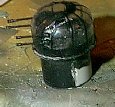 Finally, I got to the turret... oy. The two halves formed something more oval than round in shape. A quick sanding to fix the edges helped slightly, but left a gap. I fit the seat and photoetch belts in, put the console together, and started to fit the guns - which didnt' fit with the disk and guides (photoetch) that were given. I tried fitting them with the turret on - no go. Finally, after quite a bit of frustration, I pulled out the guns and the round "disks" they mounted to, glued the rest of the turret together (which fit decently, then "fed" the guns in through the elevation slots. It was a little "iffy," at first - I didn't want to break the barrells - but they finally went in and were glued into place.
Finally, I got to the turret... oy. The two halves formed something more oval than round in shape. A quick sanding to fix the edges helped slightly, but left a gap. I fit the seat and photoetch belts in, put the console together, and started to fit the guns - which didnt' fit with the disk and guides (photoetch) that were given. I tried fitting them with the turret on - no go. Finally, after quite a bit of frustration, I pulled out the guns and the round "disks" they mounted to, glued the rest of the turret together (which fit decently, then "fed" the guns in through the elevation slots. It was a little "iffy," at first - I didn't want to break the barrells - but they finally went in and were glued into place.
Whew. The turret then dropped into its home in the back, and the final bits were added.
The Defiant has a rather complex landing gear arrangement. Fortunately, this is depicted with photoetch and steel tube, which went together very well. I then fit the underside antennae and the landing gear doors. There are three bits to each door, and they don't seem to "make sense" when looking at them. It took a few tries to get them lined up per the instructions and a review on Hyperscale (link below,) but they got there. The final coat of black paint went on, and it was on to decalling.
DECALS - "Dissolves quickly and easily" should be Propagateam's slogan. The decals are stiff and uncooperative, and break easily. I found this out with the first roundel (left wing top) which cracked in two pieces. Fortunately, these went together seamlessly. The other roundel wasn't bad. I put the side markings on (one letter and one roundel crack,) Then for the final bit... the shark's mouth decal. I was looking forward to this, as it was an interesting look and fit well with the model's contours. Unfortunately, the DECAL split into more pieces than I care to admit - literally dissolving. After a futile attempt to save it, I got all the bits I could off and went on to weathering, in disgust. I may try painting this later... we'll see.
I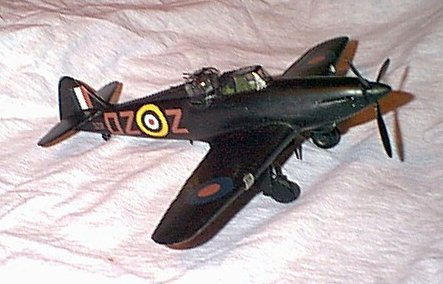 didnt' go heavily into weathering this aircraft - a few paint chips here and there, and some pastel 'exhaust' on the sides, was all I put on. I never saw any photos of these nightfighters heavily weathered, so this was as far as I took it.
didnt' go heavily into weathering this aircraft - a few paint chips here and there, and some pastel 'exhaust' on the sides, was all I put on. I never saw any photos of these nightfighters heavily weathered, so this was as far as I took it.
Comments and conlcusion - This is definately a "limited run" kit, and one of Classic Airframes' first efforts, to boot. There are a few dimensional problems, but nothing that is immediately noticable. Would I suggest this for your first multimedia or first limited run kit? No, not by a long shot - something from Czech Masters, such as their YAK-15, would work out better. But if you're familiar with using resin and photoetch, and can deal with "not-quite" fit, Classic Airframes kits such as the Defiant will provide you with an enjoyable experience and unusual subject matter.
More information about the aircraft and another kit review can be found at Internet Modeller.A walkaround can be seen at IPMS Stockholm's page.